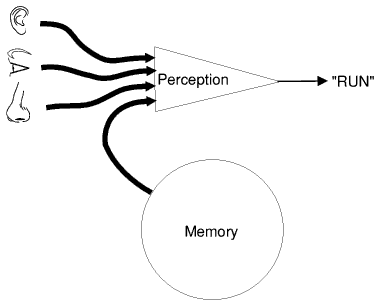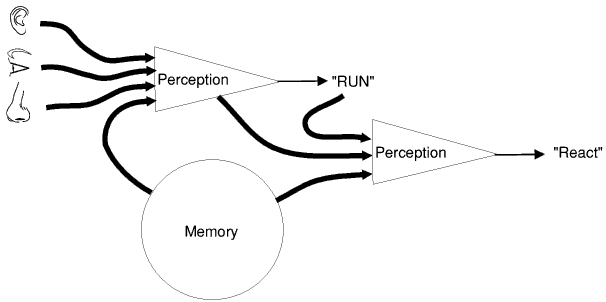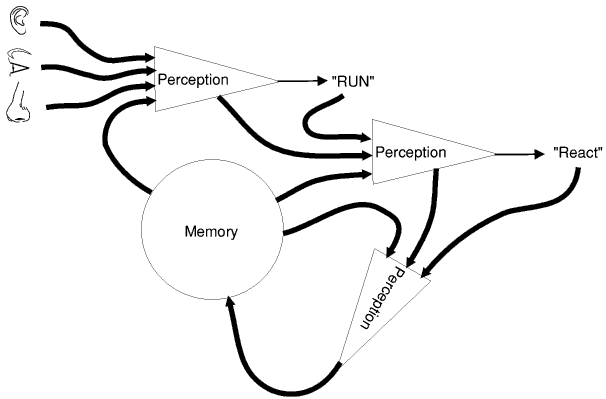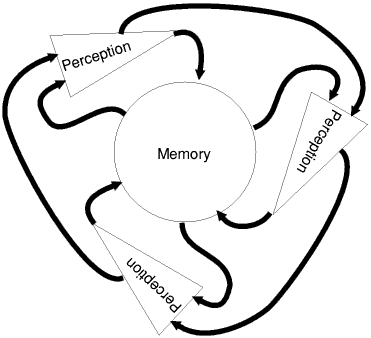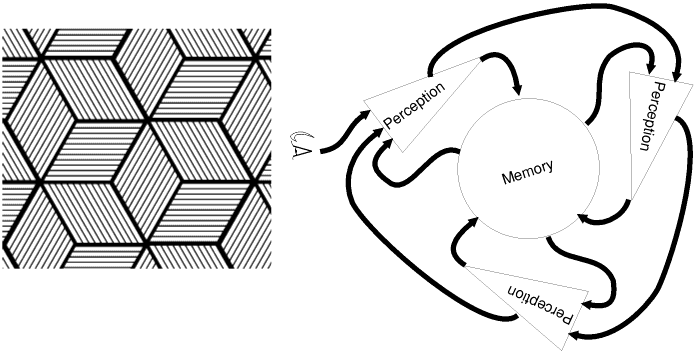The mechanism of perception is understood in broad terms: A simple output is abstracted from a large amount of complex data somewhere in the brain. The process seems to be similar to a neural net.
In the classic case of the dangerous animal hiding in a thicket, the input data come in a stream, including images, sounds and smells and also memory data. This perception process can have more than one output, in this case a fast one that says “danger” and triggers a bodily response and the impulse to run.
There may be slower outputs of things that can be learnt from the encounter like “was it really a tiger?” The next figure shown this further perception as a distinct second stage, but it is probably a continuation of the first that occurs after the initial fast response but in a larger area of the brain. The inputs to this further stage include partially perceived and still complex data from the first stage. It can also access data of learnt techniques to modify the reaction
After the fast action is over, the encounter can be examined for things that can be learnt for the experience. Again this is a continuation of the perception process taking data from all the perceiving that has occurred so far.
Anecdotally, when I “turn over” a problem in my mind, I am aware of cyclical activity. For example, just now, trying to think of the best word for what I am trying to say, I say in my head the words leading up to the unidentified word and then think of a candidate word and then revisit the idea that I am trying to express and back to saying the phrase in my head…….
Similarly, when contemplating a Necker cube, a particular cube is sometimes perceived as pointing out and sometimes pointing in, with inversions occurring at irregular intervals of order of a few seconds.
Is it significant that poetry, music and dance have elements of repetition with cycle times of a few seconds? Of the same order as seems to occur in contemplation and indeed religious practices frequently couple mindful activity with repetitious sounds and movements in aid of achieving an altered state of consciousness.
The conjecture
That consciousness involves a continued cyclic pattern of perception.
This conjecture goes very neatly with the report “A stable mind is a conscious mind” New Scientist, 11 April 2015 where it is suggested that conscious perception requires brain activity to hold steady for hundreds of milliseconds.
It also answers some philosophical problems with creativity, free will and determinism. The cyclic mental activity, the basis of consciousness, is potentially chaotic, so that the longer it continues, the less predictable and more creative our thoughts can be.
Conversely, the shorter the state of contemplation, the fewer decisions can be fully conscious and rapid reactions will be deterministic
If free will is a creative decision, it has to be made in a state of consciousness, meaning it cannot occur in less than a few seconds. This means that free-will can only be exercised on a short timescale if the dilemma involved has been already been contemplated in a state of consciousness.
Implications
Is this a novel insight? And if so, how significant is it? I suggest that it throws light on all the important aspects of what makes us human. As pointed out above, this includes creativity, free will and the rhythmic arts. The graphic arts can be seen as playing with the process of perception and reading is a process where the text is an input to contemplation that is part of prevailing consciousness.
How can this conjecture be tested? Can cyclic patterns of activity be detected with brain-scanning be correlated with reported thinking?
Could consciousness arise in the current development of AI? Computer translation is done by analysis of a large database. When a particular task is completed there is no continuation, so no consciousness. But, suppose there was a further level of analysis, of process of all the translation tasks, maybe in order to improve the quality of the translation process using feedback from the users; And then even a further layer of analysis, maybe to find patterns in the original database. Would this amount to consciousness? And would we recognise if it was?
Then there are distressing mental afflictions, depression, compulsive thoughts and traumatic memory. Are these aberrant states of consciousness? It appears that brain activity can be modified by magnetic fields, could this be used to intervene, to somehow to tip the sufferer out of a loop?
This is conjecture, the lowest form of scientific understanding. But I suggest that the questions that arise are of such profundity that it is worth notice.

